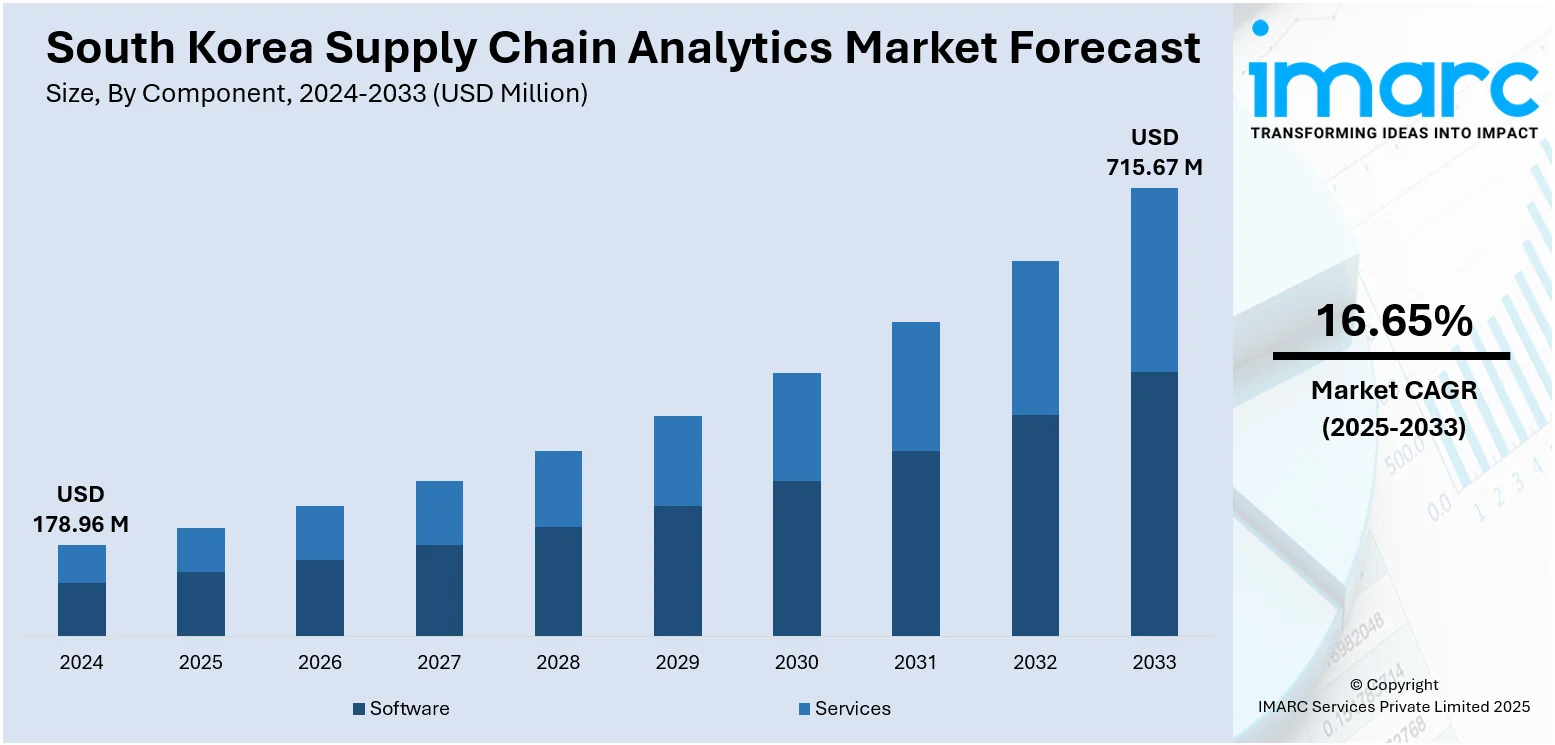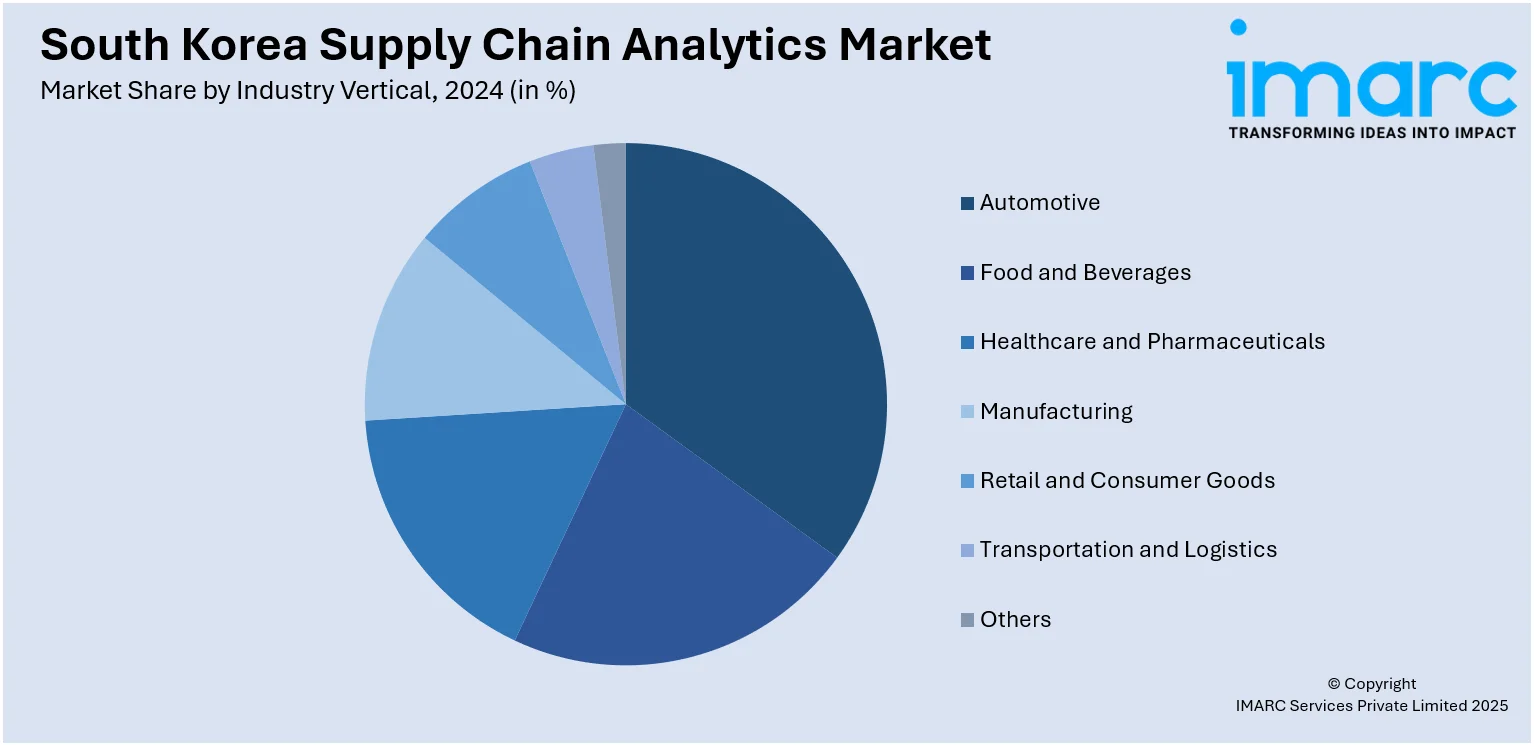
South Korea Supply Chain Analytics Market Size, Share, Trends and Forecast by Component, Deployment Mode, Enterprise Size, Industry Vertical, and Region, 2026-2034
South Korea Supply Chain Analytics Market Overview:
The South Korea supply chain analytics market size reached USD 178.96 Million in 2025. The market is projected to reach USD 715.67 Million by 2034, exhibiting a growth rate (CAGR) of 16.65% during 2026-2034. The market is fueled by the country's rapid industrial digitalization, increasing focus on predictive analytics, and rising demand for real-time supply chain visibility. Apart from this, growing e-commerce activity and the need to manage disruptions effectively have made supply chain analytics a strategic priority for organizations. Besides that, implementation of government initiatives is supporting smart manufacturing and the adoption of AI and IoT in logistics, which is further augmenting the South Korea supply chain analytics market share.
|
Report Attribute
|
Key Statistics
|
|---|---|
|
Base Year
|
2025
|
|
Forecast Years
|
2026-2034
|
|
Historical Years
|
2020-2025
|
| Market Size in 2025 | USD 178.96 Million |
| Market Forecast in 2034 | USD 715.67 Million |
| Market Growth Rate 2026-2034 | 16.65% |
South Korea Supply Chain Analytics Market Trends:
Government‑Led AI and Strategic Technology Funding
The South Korean government is taking an active role in accelerating the adoption of supply chain analytics by positioning artificial intelligence (AI) and smart manufacturing as core pillars of its industrial growth strategy. A significant portion of public funding has been directed toward upgrading the nation’s manufacturing and logistics capabilities, with a particular emphasis on AI-integrated platforms, automation, and real-time, data-driven systems. As part of this commitment, the government launched a large-scale financial initiative, pledging up to USD 7.5 Billion (KRW 10 Trillion) to support its “AI Autonomous Manufacturing” program. This initiative is designed not only to increase productivity and reduce dependence on manual processes but also to enhance the agility and responsiveness of domestic supply chains. These investments are especially relevant to the supply chain analytics market, as manufacturers and logistics providers are increasingly turning to advanced analytics to optimize operations, mitigate risks, and maintain competitiveness in key sectors like semiconductors, batteries, and precision machinery. Public-private partnerships are fostering the development of integrated analytics solutions that support real-time monitoring, dynamic demand forecasting, and logistics optimization. By encouraging a data-centric approach across manufacturing and logistics ecosystems, the government is accelerating the standardization and expansion of analytics usage in both upstream and downstream supply chain operations.

To get more information on this market, Request Sample
Surge in E‑Commerce
The rapid expansion of e-commerce in South Korea is fundamentally altering supply chain priorities and analytics adoption patterns. This trend is significantly impacting the South Korea supply chain analytics market growth. According to industry reports, in 2024, South Korea's e-commerce market is projected to grow significantly, with its value anticipated to reach approximately USD 3,810 Billion by 2033, with a CAGR of 22.3% between 2025 and 2033. Consumer expectations for same-day or next-day delivery, real-time order tracking, and seamless returns have compelled retailers and logistics providers to upgrade their systems with analytics-driven capabilities. Traditional supply chain models, optimized for efficiency and bulk delivery, are no longer adequate. Moreover, firms now require agile, data-rich infrastructure to manage fragmented, high-frequency orders. Analytics platforms are being used to forecast demand at the SKU level, optimize last-mile delivery routes, and manage distributed inventory networks. In parallel, recent global supply disruptions, ranging from pandemics to geopolitical tensions, have made resilience a central business objective. Organizations are using supply chain analytics to simulate disruption scenarios, evaluate supplier risks, and assess the financial impact of delays. This trend has led to increased investments in tools for multi-tier supplier visibility, adaptive sourcing, and buffer stock planning. The convergence of consumer-driven logistics complexity and risk mitigation needs is accelerating the shift toward predictive and prescriptive analytics.
South Korea Supply Chain Analytics Market Segmentation:
IMARC Group provides an analysis of the key trends in each segment of the market, along with forecasts at the country and regional levels for 2026-2034. Our report has categorized the market based on component, deployment mode, enterprise size, and industry vertical.
Component Insights:
- Software
- Demand Analysis and Forecasting
- Supplier Performance Analytics
- Spend and Procurement Analytics
- Inventory Analytics
- Transportation and Logistics Analytics
- Services
- Professional
- Support and Maintenance
The report has provided a detailed breakup and analysis of the market based on the component. This includes software (demand analysis and forecasting, supplier performance analytics, spend and procurement analytics, inventory analytics, and transportation and logistics analytics) and services (professional and support and maintenance).
Deployment Mode Insights:
- On-premises
- Cloud-based
A detailed breakup and analysis of the market based on the deployment mode have also been provided in the report. This includes on-premises and cloud-based.
Enterprise Size Insights:
- Large Enterprises
- Small and Medium-sized Enterprises
The report has provided a detailed breakup and analysis of the market based on the enterprise size. This includes large enterprises and small and medium-sized enterprises.
Industry Vertical Insights:

- Automotive
- Food and Beverages
- Healthcare and Pharmaceuticals
- Manufacturing
- Retail and Consumer Goods
- Transportation and Logistics
- Others
A detailed breakup and analysis of the market based on the industry vertical have also been provided in the report. This includes automotive, food and beverages, healthcare and pharmaceuticals, manufacturing, retail and consumer goods, transportation and logistics, and others.
Regional Insights:
- Seoul Capital Area
- Yeongnam (Southeastern Region)
- Honam (Southwestern Region)
- Hoseo (Central Region)
- Others
The report has also provided a comprehensive analysis of all the major regional markets, which include Seoul Capital Area, Yeongnam (Southeastern Region), Honam (Southwestern Region), Hoseo (Central Region), and others.
Competitive Landscape:
The market research report has also provided a comprehensive analysis of the competitive landscape. Competitive analysis such as market structure, key player positioning, top winning strategies, competitive dashboard, and company evaluation quadrant has been covered in the report. Also, detailed profiles of all major companies have been provided.
South Korea Supply Chain Analytics Market Report Coverage:
| Report Features | Details |
|---|---|
| Base Year of the Analysis | 2025 |
| Historical Period | 2020-2025 |
| Forecast Period | 2026-2034 |
| Units | Million USD |
| Scope of the Report |
Exploration of Historical Trends and Market Outlook, Industry Catalysts and Challenges, Segment-Wise Historical and Future Market Assessment:
|
| Components Covered |
|
| Deployment Modes Covered | On-premises, Cloud-based |
| Enterprise Sizes Covered | Large Enterprises, Small and Medium-sized Enterprises |
| Industry Verticals Covered | Automotive, Food and Beverages, Healthcare and Pharmaceuticals, Manufacturing, Retail and Consumer Goods, Transportation and Logistics, Others |
| Regions Covered | Seoul Capital Area, Yeongnam (Southeastern Region), Honam (Southwestern Region), Hoseo (Central Region), Others |
| Customization Scope | 10% Free Customization |
| Post-Sale Analyst Support | 10-12 Weeks |
| Delivery Format | PDF and Excel through Email (We can also provide the editable version of the report in PPT/Word format on special request) |
Key Questions Answered in This Report:
- How has the South Korea supply chain analytics market performed so far and how will it perform in the coming years?
- What is the breakup of the South Korea supply chain analytics market on the basis of component?
- What is the breakup of the South Korea supply chain analytics market on the basis of deployment mode?
- What is the breakup of the South Korea supply chain analytics market on the basis of enterprise size?
- What is the breakup of the South Korea supply chain analytics market on the basis of industry vertical?
- What is the breakup of the South Korea supply chain analytics market on the basis of region?
- What are the various stages in the value chain of the South Korea supply chain analytics market?
- What are the key driving factors and challenges in the South Korea supply chain analytics market?
- What is the structure of the South Korea supply chain analytics market and who are the key players?
- What is the degree of competition in the South Korea supply chain analytics market?
Key Benefits for Stakeholders:
- IMARC’s industry report offers a comprehensive quantitative analysis of various market segments, historical and current market trends, market forecasts, and dynamics of the South Korea supply chain analytics market from 2020-2034.
- The research report provides the latest information on the market drivers, challenges, and opportunities in the South Korea supply chain analytics market.
- Porter's five forces analysis assist stakeholders in assessing the impact of new entrants, competitive rivalry, supplier power, buyer power, and the threat of substitution. It helps stakeholders to analyze the level of competition within the South Korea supply chain analytics industry and its attractiveness.
- Competitive landscape allows stakeholders to understand their competitive environment and provides an insight into the current positions of key players in the market.
Need more help?
- Speak to our experienced analysts for insights on the current market scenarios.
- Include additional segments and countries to customize the report as per your requirement.
- Gain an unparalleled competitive advantage in your domain by understanding how to utilize the report and positively impacting your operations and revenue.
- For further assistance, please connect with our analysts.
 Request Customization
Request Customization
 Speak to an Analyst
Speak to an Analyst
 Request Brochure
Request Brochure
 Inquire Before Buying
Inquire Before Buying




.webp)




.webp)












